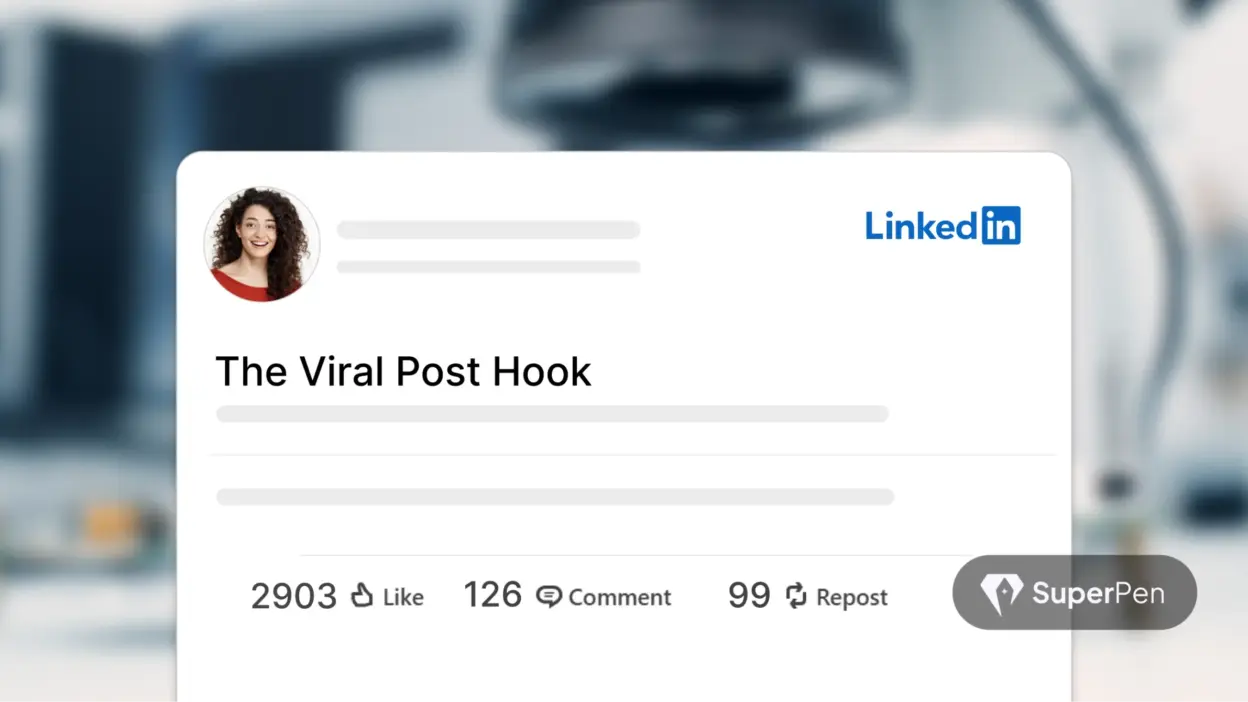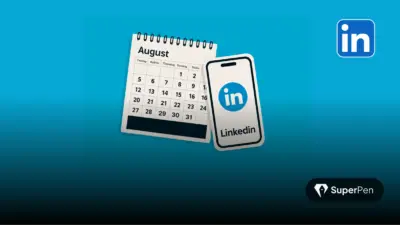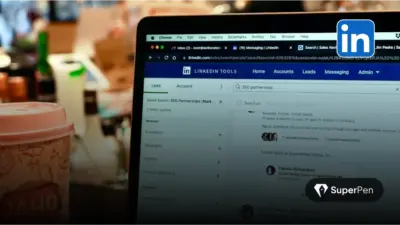You’ve got 3 seconds.
That’s how long it takes someone to decide whether your LinkedIn post is worth reading – or worth skipping.
And no, it’s not your graphic. It’s not even your story. It’s that first line.
The hook.
The right hook can stop a seasoned scroller mid-coffee. It pulls them in, piques their curiosity, and quietly whispers: “This is going to be good.”
Truth is, 90% of your post’s performance depends on your opening line.
Not a vibe. A fact.
In this breakdown, we’re going deep:
- The science behind viral hooks
- 5 Proven hook types (with real examples that crushed it)
- Templates you can steal and test today
Let’s make sure your next post doesn’t just show up-it shows out.
Table of Contents
Types of Viral Hooks
Each hook type appeals to one of our psychological triggers: curiosity, authority, empathy, or surprise.
1. Statistic or Surprising Number
Data speaks volumes-and cuts through the noise.
Real Example:
- Reno Perry: “73 % of employers expect you to negotiate – 55 % of professionals don’t.”
- Why it works: A surprising stat, relevant to job seekers. It uncovers a hidden problem, prompting readers to think, “Am I leaving money on the table?”
2. Bold or Contrarian Statement
Challenge the status quo to hook attention.
Real Example:
Justin Welsh: “Most creator entrepreneurs fail for the same reason…”
Why it works: It’s provocative and suggests inside knowledge-readers want to know why.
3. Personal‑Story Viral Hook
Vulnerability builds trust and connection – it shows the human behind the profile.
📌 Real Example from Suniel Shetty:
“It’s funny how life works. You spend years chasing things you think will make you happy… But you know what I’ve learned? Real joy mainly comes from the simplest of things. Becoming a grandfather recently – is a feeling I can’t even describe.”
Why it works:
- Opens with a relatable reflection (“It’s funny how life works”)
- Shares a journey: ambition → realisation → emotional payoff
- Emotion-driven (“I can’t even describe”) and deeply human
Suniel’s hook feels like he’s talking over coffee – relatable, heartfelt, and impossible to scroll past.
4. Problem + Promise Hook
This classic structure shows you “get it”-then gives a solution.
Template Example:
“Struggling to get profile views? Here’s what actually worked for me.”
Why it works:
- Opens with empathy (“struggling”)
- Then offers a concrete benefit (“here’s what worked”)
📌 Real Example from Saheli Chatterjee:
“Right, this is an unpopular idea – But YOU BEST read it, because it will be the most important marketing advice you read all day”
Why it nails it:
- Identifies a gap: unpopular idea
- Promises high value: “most important marketing advice”
- Builds urgency: “YOU BEST read it”
This hook empathises with marketers tired of trend-chasing, then offers exactly what they want-fresh, valuable insight. That’s the magic combo: problem + promise + a dash of urgency.
5. Mini‑Story or One‑Line Anecdote
Invoke curiosity and emotion in just a single line.
Template Example:
“I walked out of a VC meeting with nothing-except one lesson that made me millions.”
Why it works:
- Instantly hints at conflict and payoff
- Builds intrigue without giving the full story away
📌 Real Example from Anupam Mittal:
“In my 20s, I smoked a pack a day…[now] I’m trying to let go of this situationship.”
Why it hits hard:
- Opens with a personal confession (“I smoked a pack a day”)
- Sets up a long journey-emotional, internal, relatable
- Leaves you wanting to know: What changed? How did he quit?
Anupam’s one-line anecdote captures transformation and tension in under 20 words-exactly the kind of hook that stops scrolls and draws readers into the rest of the story.
Viral Hook Comparison:
| Hook Type | Example | Why It Works |
| Statistical Shock | “73 %…55 %…” – Reno Perry | Surprising data combined with a pointed problem |
| Contrarian Boldness | “Most creator entrepreneurs fail…” – Justin Welsh | Bold intro + curiosity → promise of insider insight |
| Personal-Story Hook | “It’s funny how life works…” – Suniel Shetty | Starts with reflection, leads to emotion, and builds trust with vulnerability |
| Problem + Promise | “Right, this is an unpopular idea-But YOU BEST read it…” – Saheli Chatterjee | Empathizes with trend-fatigue, promises unique value + urgency |
| Mini‑Story/Anecdote | “In my 20s, I smoked a pack a day…” – Anupam Mittal | Captures conflict and transformation in one line – emotional and relatable |
Each example blends one or more hook styles-often mixing stat + problem, boldness + curiosity, or personal insight-to create maximum impact in mere words.
Viral Hook Templates You Can Use Today
Here are plug-and-play templates mapped to the hook styles:
- Statistic Hook:
Did you know [X %] of [your audience] [pain point]? - Contrarian Hook:
Here’s what most [professionals] *don’t* realize: [big claim]. - Curiosity Question:
What if I told you [surprising insight] about [topic]? - Personal Story:
[Time] ago, I [struggle/action]. Now I [result]-here’s how. - Pain‑Point Promise:
Tired of [challenge]? Here’s what finally worked. - Mini‑Story Anecdote:
I [unexpected twist]-and learned [big lesson]. - Reframe/Challenge:
[Common belief]? Think again: [new perspective].
Use these to A/B test your first lines – which means write 3–5 versions of your hook, post (or preview) them in different formats, and track which one grabs the most curiosity or engagement.
Viral Hook Writing Tips – The Science Behind the Scroll‑Stopper
- Keep It Short & Punchy – 1–2 lines (≈50–60 characters) before the “See more” cut-off.
- Copywriting Formulas Work – AIDA stands for Attention, Interest, Desire, Action – it guides readers from curiosity to conversion.
PAS means Problem, Agitate, Solution – you hit a pain point, stir it up, then offer the fix.
- Pattern Interrupt – Use unexpected words: “I just got fired…” or “We all lied about this…”
- Show Empathy + Authority – Try: “I used to post and hear nothing… then I learned XYZ.”
- A/B Test Always – Successful writers often run multiple hooks, choose the highest-performing one.
Related read: How to Go Viral on LinkedIn | Save, Draft, Repeat: LinkedIn’s Secret Features You’re Not Using
Tips for LinkedIn’s Latest Algorithm Update
LinkedIn now favours people-first, content-authentic, helpful, and story-driven, not SEO game-playing. Here’s how to adapt:
- Write for people first: Your opening should serve your reader-not the algorithm.
- Leverage lived experience: Real anecdotes and first-hand insight build trust.
- Deliver satisfaction: Posts should teach or inspire clearly and fully.
- Don’t just post-provoke: Your job isn’t done when you hit publish. Ask a question. Start a debate. Invite stories. The more people talk, the more LinkedIn listens.
- The algorithm loves a good back-and-forth: Show up in your own comments. Respond early, reply often. It’s not “engagement” if you ghost your audience. It’s a conversation – be a part of it.
If your hook and content prioritise value, your posts are set up for LinkedIn’s updated norms.
Conclusion
The best viral hooks aren’t just clever-they’re calculated. A little surprise, a touch of authority, a pinch of emotion, and sharp relevance – that’s the mix. So here’s your move: pick a template, draft three hook variations for your next post, and A/B test them. See which one earns the scroll – that’s your keeper.
Frequently Asked Questions (FAQS)
Q1: How long should a LinkedIn hook be?
Aim for 1–2 short lines, ~50–60 characters. Anything more risks being cut off.
Q2: Which hook gets the most engagement?
Stats and bold claims tend to draw clicks and comments. Data-driven statements especially catch eyes.
Q3: Can I use humour in a hook?
Yes-if it aligns with your brand and supports the message. Light humour humanises your post.
Q4: How often should I test new hooks?
Every few posts. Writing 3–5 options and using the most curiosity-driven one is a great habit.
Q5: What if I’m not confident yet?
Start with empathy-based or problem-focused hooks, and share your journey – credibility grows over time.





